Leadership Capabilities and Transition Strategies: An Essay Analysis
VerifiedAdded on 2022/11/17
|30
|12000
|328
Essay
AI Summary
This essay examines leadership capabilities and transition strategies for individual improvement within a chosen workplace or organization. It explores self-management and relationship-building aspects of leadership, evaluating them within a specific context. The essay then delves into the implementation of transition strategies designed to enhance individual leadership abilities. The structure includes an introduction, body paragraphs, and a conclusion, with attention given to English language proficiency, grammar, and proper citation using APA referencing. The assignment focuses on providing a comprehensive analysis of leadership, offering practical strategies for personal and professional development in a business setting. It evaluates how leaders can adapt to changes in consumer behavior and business trading patterns. The essay also uses the iceberg model of virtues to illustrate the importance of deeper levels of cultural change in business decision-making.
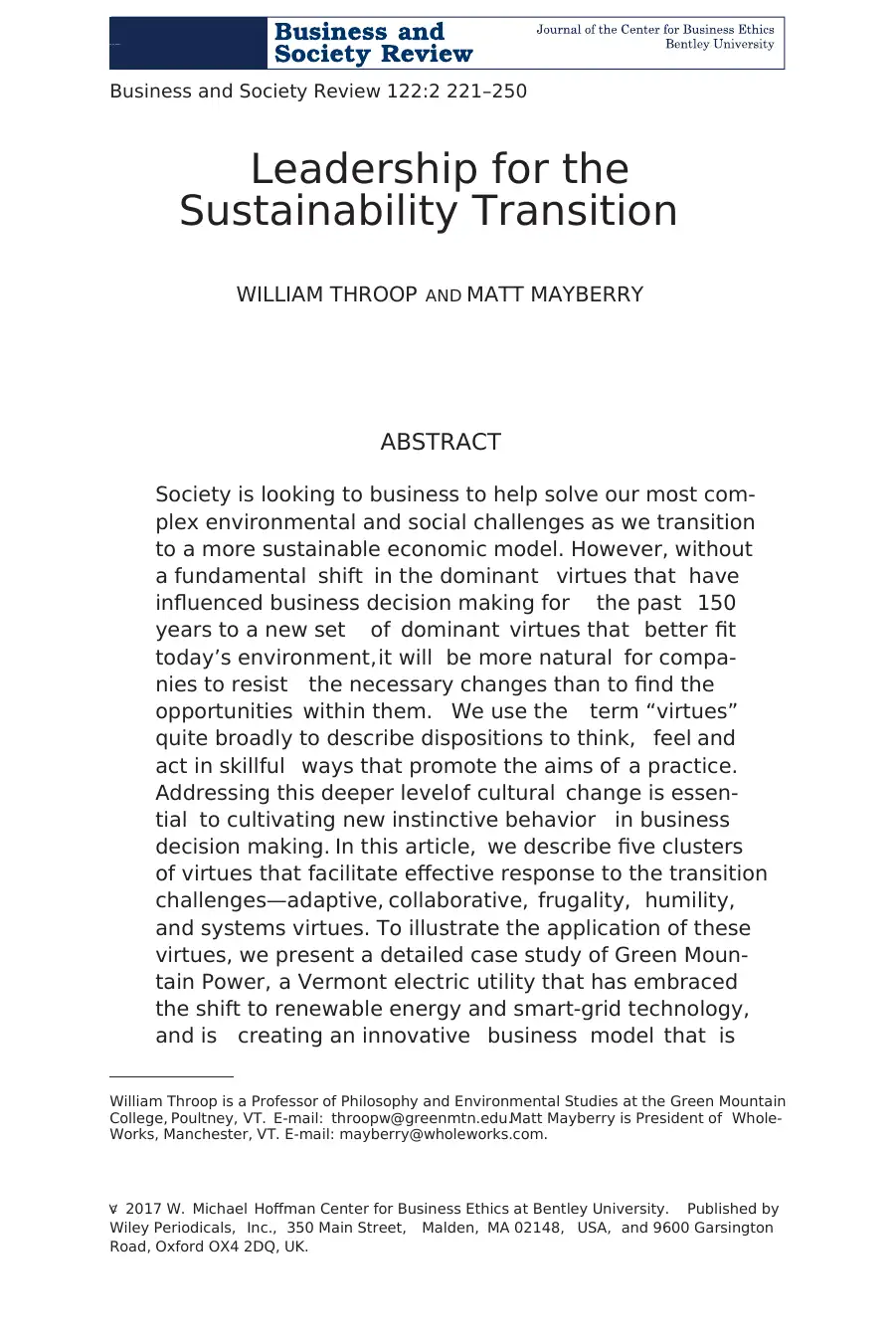
Leadership for the
Sustainability Transition
WILLIAM THROOP AND MATT MAYBERRY
ABSTRACT
Society is looking to business to help solve our most com-
plex environmental and social challenges as we transition
to a more sustainable economic model. However, without
a fundamental shift in the dominant virtues that have
influenced business decision making for the past 150
years to a new set of dominant virtues that better fit
today’s environment,it will be more natural for compa-
nies to resist the necessary changes than to find the
opportunities within them. We use the term “virtues”
quite broadly to describe dispositions to think, feel and
act in skillful ways that promote the aims of a practice.
Addressing this deeper levelof cultural change is essen-
tial to cultivating new instinctive behavior in business
decision making. In this article, we describe five clusters
of virtues that facilitate effective response to the transition
challenges—adaptive, collaborative, frugality, humility,
and systems virtues. To illustrate the application of these
virtues, we present a detailed case study of Green Moun-
tain Power, a Vermont electric utility that has embraced
the shift to renewable energy and smart-grid technology,
and is creating an innovative business model that is
William Throop is a Professor of Philosophy and Environmental Studies at the Green Mountain
College, Poultney, VT. E-mail: throopw@greenmtn.edu.Matt Mayberry is President of Whole-
Works, Manchester, VT. E-mail: mayberry@wholeworks.com.
VC 2017 W. Michael Hoffman Center for Business Ethics at Bentley University. Published by
Wiley Periodicals, Inc., 350 Main Street, Malden, MA 02148, USA, and 9600 Garsington
Road, Oxford OX4 2DQ, UK.
Business and Society Review 122:2 221–250
bs_bs_banner
Sustainability Transition
WILLIAM THROOP AND MATT MAYBERRY
ABSTRACT
Society is looking to business to help solve our most com-
plex environmental and social challenges as we transition
to a more sustainable economic model. However, without
a fundamental shift in the dominant virtues that have
influenced business decision making for the past 150
years to a new set of dominant virtues that better fit
today’s environment,it will be more natural for compa-
nies to resist the necessary changes than to find the
opportunities within them. We use the term “virtues”
quite broadly to describe dispositions to think, feel and
act in skillful ways that promote the aims of a practice.
Addressing this deeper levelof cultural change is essen-
tial to cultivating new instinctive behavior in business
decision making. In this article, we describe five clusters
of virtues that facilitate effective response to the transition
challenges—adaptive, collaborative, frugality, humility,
and systems virtues. To illustrate the application of these
virtues, we present a detailed case study of Green Moun-
tain Power, a Vermont electric utility that has embraced
the shift to renewable energy and smart-grid technology,
and is creating an innovative business model that is
William Throop is a Professor of Philosophy and Environmental Studies at the Green Mountain
College, Poultney, VT. E-mail: throopw@greenmtn.edu.Matt Mayberry is President of Whole-
Works, Manchester, VT. E-mail: mayberry@wholeworks.com.
VC 2017 W. Michael Hoffman Center for Business Ethics at Bentley University. Published by
Wiley Periodicals, Inc., 350 Main Street, Malden, MA 02148, USA, and 9600 Garsington
Road, Oxford OX4 2DQ, UK.
Business and Society Review 122:2 221–250
bs_bs_banner
Paraphrase This Document
Need a fresh take? Get an instant paraphrase of this document with our AI Paraphraser
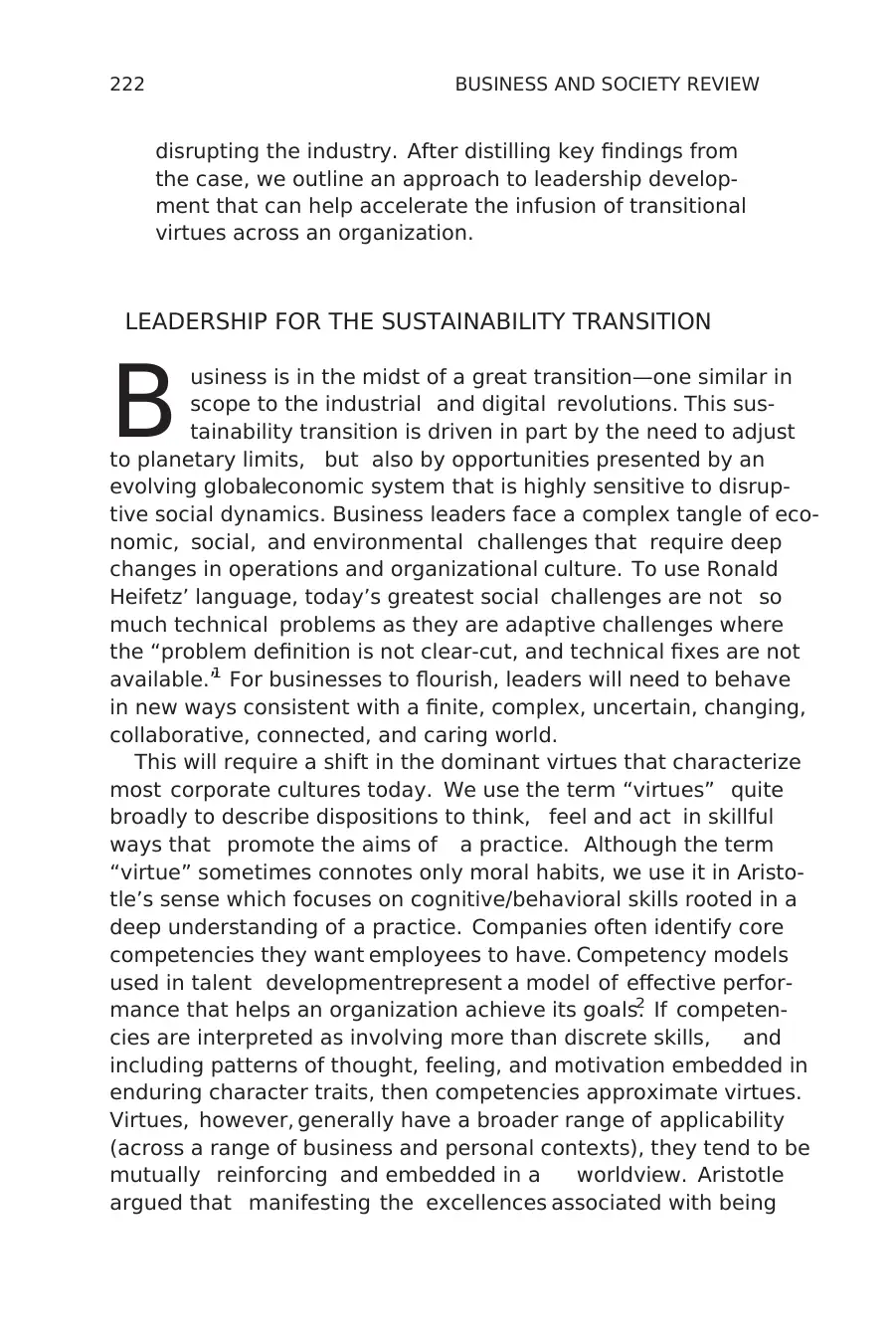
disrupting the industry. After distilling key findings from
the case, we outline an approach to leadership develop-
ment that can help accelerate the infusion of transitional
virtues across an organization.
LEADERSHIP FOR THE SUSTAINABILITY TRANSITION
B usiness is in the midst of a great transition—one similar in
scope to the industrial and digital revolutions. This sus-
tainability transition is driven in part by the need to adjust
to planetary limits, but also by opportunities presented by an
evolving globaleconomic system that is highly sensitive to disrup-
tive social dynamics. Business leaders face a complex tangle of eco-
nomic, social, and environmental challenges that require deep
changes in operations and organizational culture. To use Ronald
Heifetz’ language, today’s greatest social challenges are not so
much technical problems as they are adaptive challenges where
the “problem definition is not clear-cut, and technical fixes are not
available.”1 For businesses to flourish, leaders will need to behave
in new ways consistent with a finite, complex, uncertain, changing,
collaborative, connected, and caring world.
This will require a shift in the dominant virtues that characterize
most corporate cultures today. We use the term “virtues” quite
broadly to describe dispositions to think, feel and act in skillful
ways that promote the aims of a practice. Although the term
“virtue” sometimes connotes only moral habits, we use it in Aristo-
tle’s sense which focuses on cognitive/behavioral skills rooted in a
deep understanding of a practice. Companies often identify core
competencies they want employees to have. Competency models
used in talent developmentrepresent a model of effective perfor-
mance that helps an organization achieve its goals.2 If competen-
cies are interpreted as involving more than discrete skills, and
including patterns of thought, feeling, and motivation embedded in
enduring character traits, then competencies approximate virtues.
Virtues, however, generally have a broader range of applicability
(across a range of business and personal contexts), they tend to be
mutually reinforcing and embedded in a worldview. Aristotle
argued that manifesting the excellences associated with being
222 BUSINESS AND SOCIETY REVIEW
the case, we outline an approach to leadership develop-
ment that can help accelerate the infusion of transitional
virtues across an organization.
LEADERSHIP FOR THE SUSTAINABILITY TRANSITION
B usiness is in the midst of a great transition—one similar in
scope to the industrial and digital revolutions. This sus-
tainability transition is driven in part by the need to adjust
to planetary limits, but also by opportunities presented by an
evolving globaleconomic system that is highly sensitive to disrup-
tive social dynamics. Business leaders face a complex tangle of eco-
nomic, social, and environmental challenges that require deep
changes in operations and organizational culture. To use Ronald
Heifetz’ language, today’s greatest social challenges are not so
much technical problems as they are adaptive challenges where
the “problem definition is not clear-cut, and technical fixes are not
available.”1 For businesses to flourish, leaders will need to behave
in new ways consistent with a finite, complex, uncertain, changing,
collaborative, connected, and caring world.
This will require a shift in the dominant virtues that characterize
most corporate cultures today. We use the term “virtues” quite
broadly to describe dispositions to think, feel and act in skillful
ways that promote the aims of a practice. Although the term
“virtue” sometimes connotes only moral habits, we use it in Aristo-
tle’s sense which focuses on cognitive/behavioral skills rooted in a
deep understanding of a practice. Companies often identify core
competencies they want employees to have. Competency models
used in talent developmentrepresent a model of effective perfor-
mance that helps an organization achieve its goals.2 If competen-
cies are interpreted as involving more than discrete skills, and
including patterns of thought, feeling, and motivation embedded in
enduring character traits, then competencies approximate virtues.
Virtues, however, generally have a broader range of applicability
(across a range of business and personal contexts), they tend to be
mutually reinforcing and embedded in a worldview. Aristotle
argued that manifesting the excellences associated with being
222 BUSINESS AND SOCIETY REVIEW
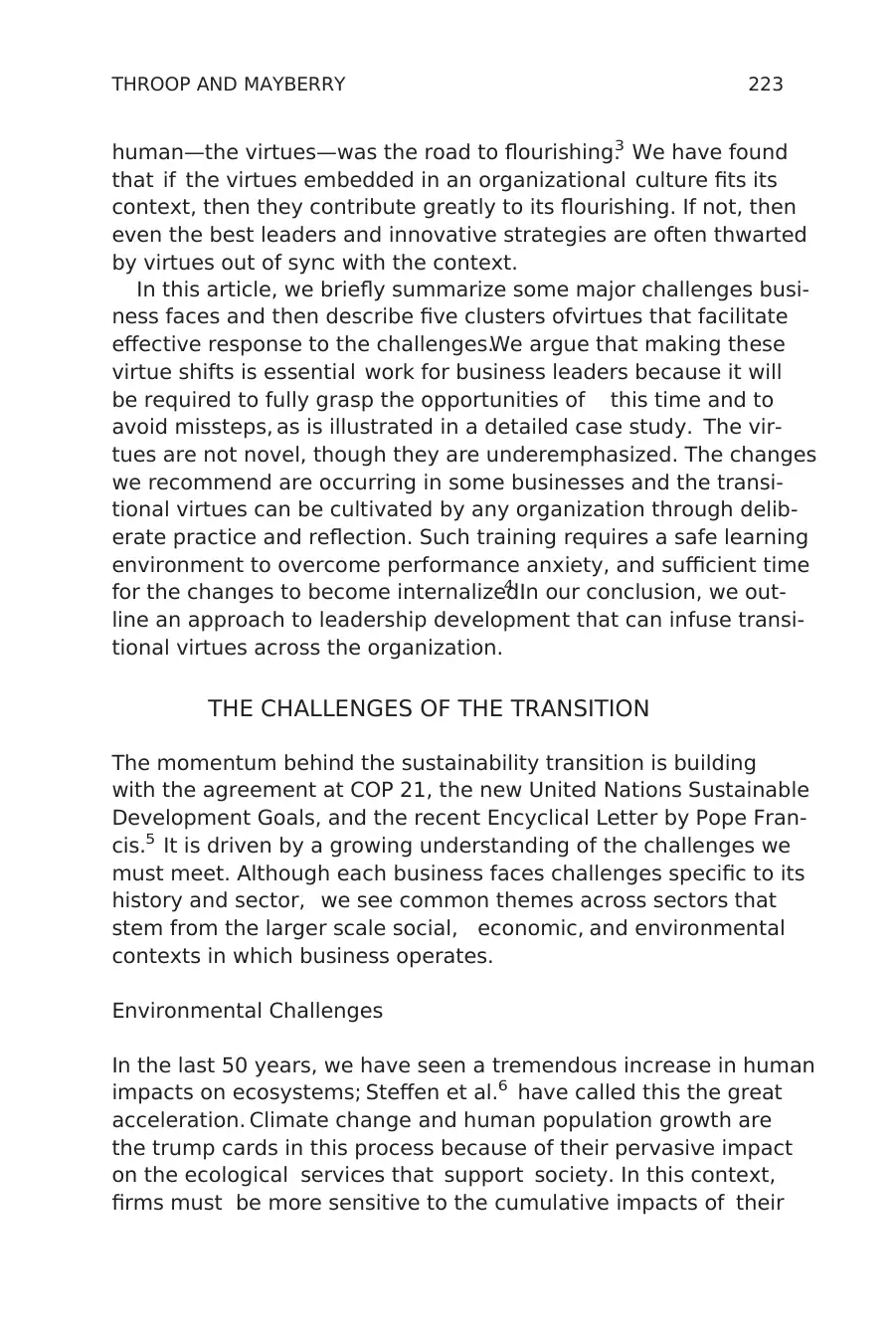
human—the virtues—was the road to flourishing.3 We have found
that if the virtues embedded in an organizational culture fits its
context, then they contribute greatly to its flourishing. If not, then
even the best leaders and innovative strategies are often thwarted
by virtues out of sync with the context.
In this article, we briefly summarize some major challenges busi-
ness faces and then describe five clusters ofvirtues that facilitate
effective response to the challenges.We argue that making these
virtue shifts is essential work for business leaders because it will
be required to fully grasp the opportunities of this time and to
avoid missteps, as is illustrated in a detailed case study. The vir-
tues are not novel, though they are underemphasized. The changes
we recommend are occurring in some businesses and the transi-
tional virtues can be cultivated by any organization through delib-
erate practice and reflection. Such training requires a safe learning
environment to overcome performance anxiety, and sufficient time
for the changes to become internalized.4 In our conclusion, we out-
line an approach to leadership development that can infuse transi-
tional virtues across the organization.
THE CHALLENGES OF THE TRANSITION
The momentum behind the sustainability transition is building
with the agreement at COP 21, the new United Nations Sustainable
Development Goals, and the recent Encyclical Letter by Pope Fran-
cis.5 It is driven by a growing understanding of the challenges we
must meet. Although each business faces challenges specific to its
history and sector, we see common themes across sectors that
stem from the larger scale social, economic, and environmental
contexts in which business operates.
Environmental Challenges
In the last 50 years, we have seen a tremendous increase in human
impacts on ecosystems; Steffen et al.6 have called this the great
acceleration. Climate change and human population growth are
the trump cards in this process because of their pervasive impact
on the ecological services that support society. In this context,
firms must be more sensitive to the cumulative impacts of their
223THROOP AND MAYBERRY
that if the virtues embedded in an organizational culture fits its
context, then they contribute greatly to its flourishing. If not, then
even the best leaders and innovative strategies are often thwarted
by virtues out of sync with the context.
In this article, we briefly summarize some major challenges busi-
ness faces and then describe five clusters ofvirtues that facilitate
effective response to the challenges.We argue that making these
virtue shifts is essential work for business leaders because it will
be required to fully grasp the opportunities of this time and to
avoid missteps, as is illustrated in a detailed case study. The vir-
tues are not novel, though they are underemphasized. The changes
we recommend are occurring in some businesses and the transi-
tional virtues can be cultivated by any organization through delib-
erate practice and reflection. Such training requires a safe learning
environment to overcome performance anxiety, and sufficient time
for the changes to become internalized.4 In our conclusion, we out-
line an approach to leadership development that can infuse transi-
tional virtues across the organization.
THE CHALLENGES OF THE TRANSITION
The momentum behind the sustainability transition is building
with the agreement at COP 21, the new United Nations Sustainable
Development Goals, and the recent Encyclical Letter by Pope Fran-
cis.5 It is driven by a growing understanding of the challenges we
must meet. Although each business faces challenges specific to its
history and sector, we see common themes across sectors that
stem from the larger scale social, economic, and environmental
contexts in which business operates.
Environmental Challenges
In the last 50 years, we have seen a tremendous increase in human
impacts on ecosystems; Steffen et al.6 have called this the great
acceleration. Climate change and human population growth are
the trump cards in this process because of their pervasive impact
on the ecological services that support society. In this context,
firms must be more sensitive to the cumulative impacts of their
223THROOP AND MAYBERRY
⊘ This is a preview!⊘
Do you want full access?
Subscribe today to unlock all pages.

Trusted by 1+ million students worldwide
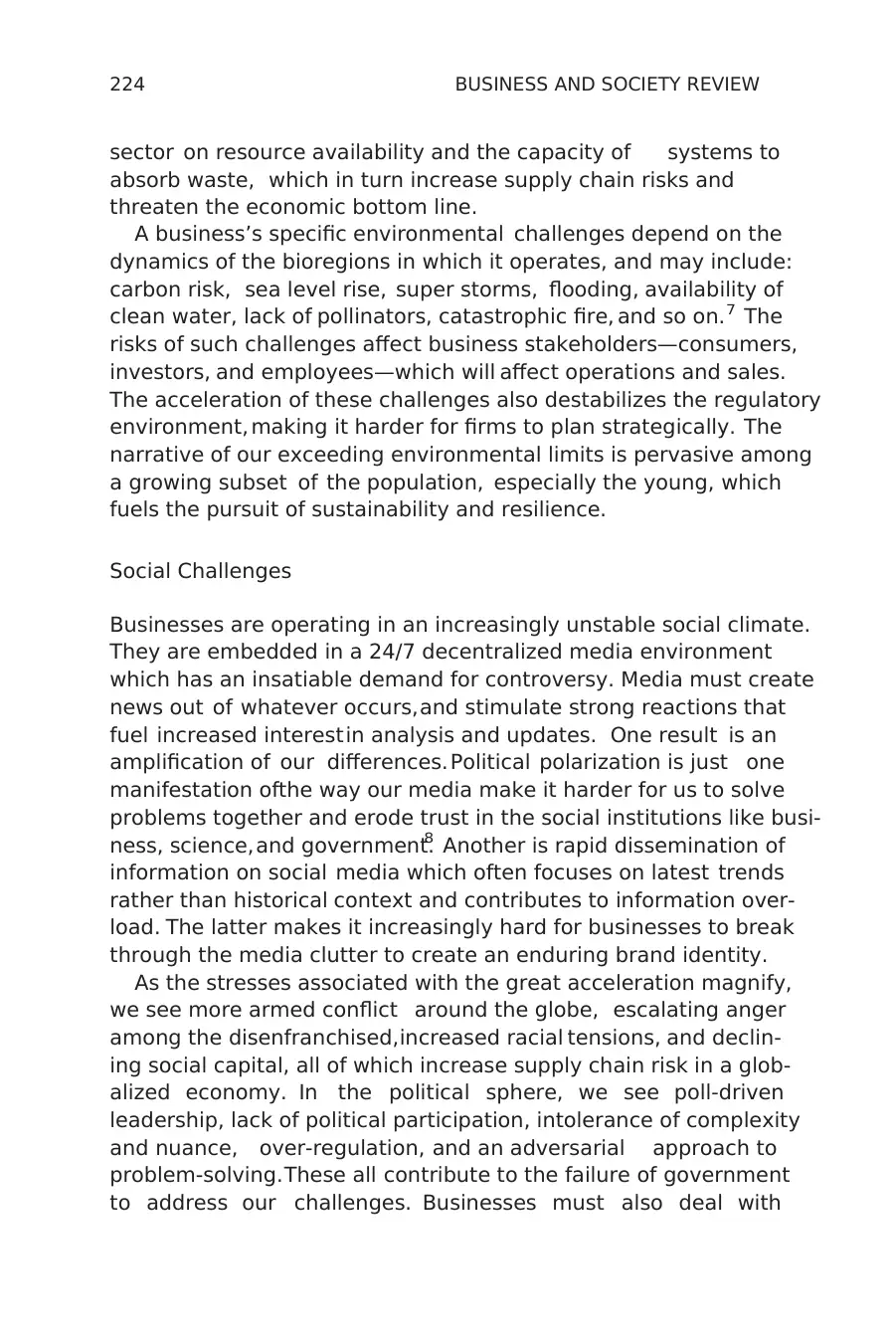
sector on resource availability and the capacity of systems to
absorb waste, which in turn increase supply chain risks and
threaten the economic bottom line.
A business’s specific environmental challenges depend on the
dynamics of the bioregions in which it operates, and may include:
carbon risk, sea level rise, super storms, flooding, availability of
clean water, lack of pollinators, catastrophic fire, and so on. 7 The
risks of such challenges affect business stakeholders—consumers,
investors, and employees—which will affect operations and sales.
The acceleration of these challenges also destabilizes the regulatory
environment, making it harder for firms to plan strategically. The
narrative of our exceeding environmental limits is pervasive among
a growing subset of the population, especially the young, which
fuels the pursuit of sustainability and resilience.
Social Challenges
Businesses are operating in an increasingly unstable social climate.
They are embedded in a 24/7 decentralized media environment
which has an insatiable demand for controversy. Media must create
news out of whatever occurs,and stimulate strong reactions that
fuel increased interestin analysis and updates. One result is an
amplification of our differences.Political polarization is just one
manifestation ofthe way our media make it harder for us to solve
problems together and erode trust in the social institutions like busi-
ness, science,and government.8 Another is rapid dissemination of
information on social media which often focuses on latest trends
rather than historical context and contributes to information over-
load. The latter makes it increasingly hard for businesses to break
through the media clutter to create an enduring brand identity.
As the stresses associated with the great acceleration magnify,
we see more armed conflict around the globe, escalating anger
among the disenfranchised,increased racial tensions, and declin-
ing social capital, all of which increase supply chain risk in a glob-
alized economy. In the political sphere, we see poll-driven
leadership, lack of political participation, intolerance of complexity
and nuance, over-regulation, and an adversarial approach to
problem-solving.These all contribute to the failure of government
to address our challenges. Businesses must also deal with
224 BUSINESS AND SOCIETY REVIEW
absorb waste, which in turn increase supply chain risks and
threaten the economic bottom line.
A business’s specific environmental challenges depend on the
dynamics of the bioregions in which it operates, and may include:
carbon risk, sea level rise, super storms, flooding, availability of
clean water, lack of pollinators, catastrophic fire, and so on. 7 The
risks of such challenges affect business stakeholders—consumers,
investors, and employees—which will affect operations and sales.
The acceleration of these challenges also destabilizes the regulatory
environment, making it harder for firms to plan strategically. The
narrative of our exceeding environmental limits is pervasive among
a growing subset of the population, especially the young, which
fuels the pursuit of sustainability and resilience.
Social Challenges
Businesses are operating in an increasingly unstable social climate.
They are embedded in a 24/7 decentralized media environment
which has an insatiable demand for controversy. Media must create
news out of whatever occurs,and stimulate strong reactions that
fuel increased interestin analysis and updates. One result is an
amplification of our differences.Political polarization is just one
manifestation ofthe way our media make it harder for us to solve
problems together and erode trust in the social institutions like busi-
ness, science,and government.8 Another is rapid dissemination of
information on social media which often focuses on latest trends
rather than historical context and contributes to information over-
load. The latter makes it increasingly hard for businesses to break
through the media clutter to create an enduring brand identity.
As the stresses associated with the great acceleration magnify,
we see more armed conflict around the globe, escalating anger
among the disenfranchised,increased racial tensions, and declin-
ing social capital, all of which increase supply chain risk in a glob-
alized economy. In the political sphere, we see poll-driven
leadership, lack of political participation, intolerance of complexity
and nuance, over-regulation, and an adversarial approach to
problem-solving.These all contribute to the failure of government
to address our challenges. Businesses must also deal with
224 BUSINESS AND SOCIETY REVIEW
Paraphrase This Document
Need a fresh take? Get an instant paraphrase of this document with our AI Paraphraser
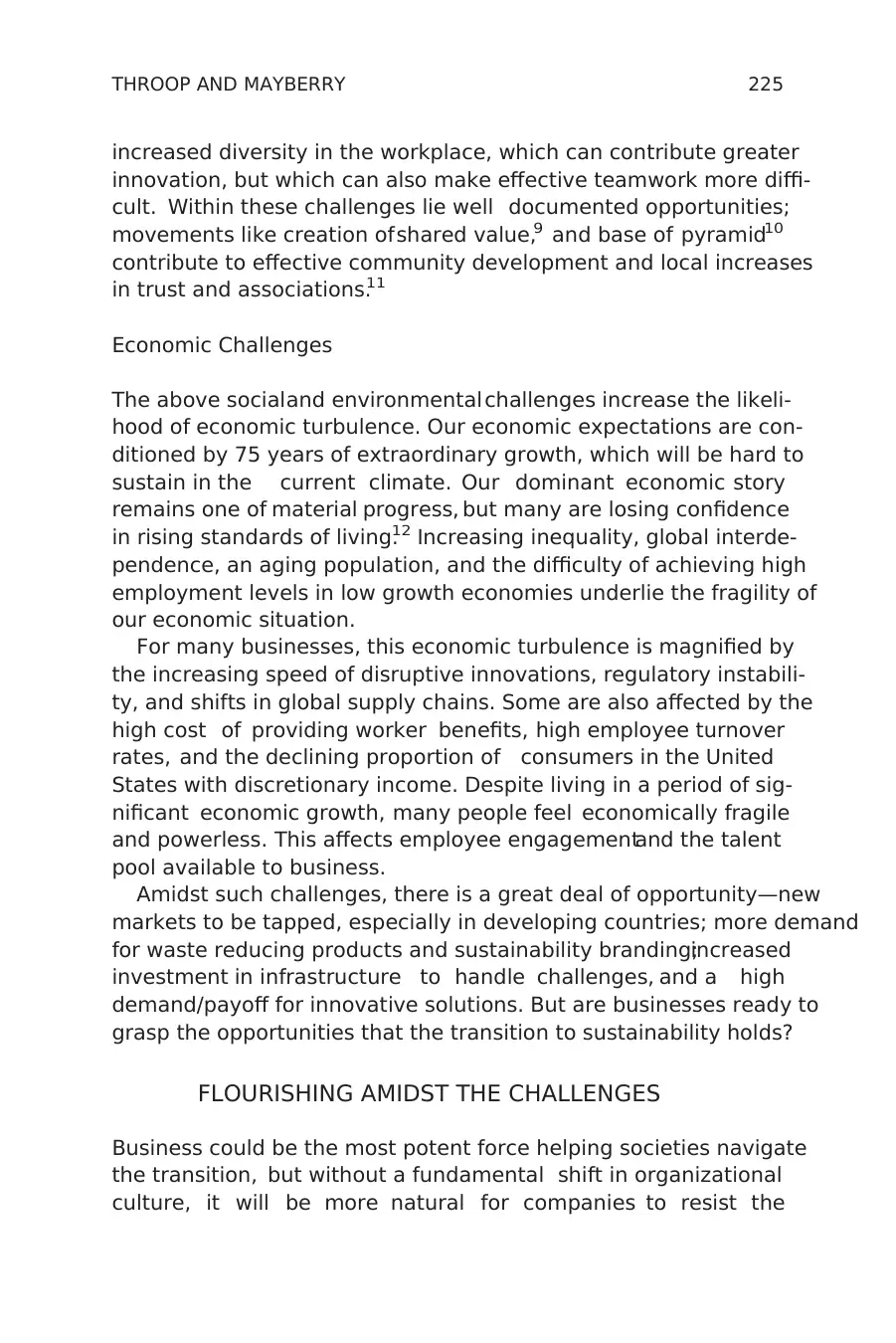
increased diversity in the workplace, which can contribute greater
innovation, but which can also make effective teamwork more diffi-
cult. Within these challenges lie well documented opportunities;
movements like creation ofshared value,9 and base of pyramid10
contribute to effective community development and local increases
in trust and associations.11
Economic Challenges
The above socialand environmental challenges increase the likeli-
hood of economic turbulence. Our economic expectations are con-
ditioned by 75 years of extraordinary growth, which will be hard to
sustain in the current climate. Our dominant economic story
remains one of material progress, but many are losing confidence
in rising standards of living.12 Increasing inequality, global interde-
pendence, an aging population, and the difficulty of achieving high
employment levels in low growth economies underlie the fragility of
our economic situation.
For many businesses, this economic turbulence is magnified by
the increasing speed of disruptive innovations, regulatory instabili-
ty, and shifts in global supply chains. Some are also affected by the
high cost of providing worker benefits, high employee turnover
rates, and the declining proportion of consumers in the United
States with discretionary income. Despite living in a period of sig-
nificant economic growth, many people feel economically fragile
and powerless. This affects employee engagementand the talent
pool available to business.
Amidst such challenges, there is a great deal of opportunity—new
markets to be tapped, especially in developing countries; more demand
for waste reducing products and sustainability branding;increased
investment in infrastructure to handle challenges, and a high
demand/payoff for innovative solutions. But are businesses ready to
grasp the opportunities that the transition to sustainability holds?
FLOURISHING AMIDST THE CHALLENGES
Business could be the most potent force helping societies navigate
the transition, but without a fundamental shift in organizational
culture, it will be more natural for companies to resist the
225THROOP AND MAYBERRY
innovation, but which can also make effective teamwork more diffi-
cult. Within these challenges lie well documented opportunities;
movements like creation ofshared value,9 and base of pyramid10
contribute to effective community development and local increases
in trust and associations.11
Economic Challenges
The above socialand environmental challenges increase the likeli-
hood of economic turbulence. Our economic expectations are con-
ditioned by 75 years of extraordinary growth, which will be hard to
sustain in the current climate. Our dominant economic story
remains one of material progress, but many are losing confidence
in rising standards of living.12 Increasing inequality, global interde-
pendence, an aging population, and the difficulty of achieving high
employment levels in low growth economies underlie the fragility of
our economic situation.
For many businesses, this economic turbulence is magnified by
the increasing speed of disruptive innovations, regulatory instabili-
ty, and shifts in global supply chains. Some are also affected by the
high cost of providing worker benefits, high employee turnover
rates, and the declining proportion of consumers in the United
States with discretionary income. Despite living in a period of sig-
nificant economic growth, many people feel economically fragile
and powerless. This affects employee engagementand the talent
pool available to business.
Amidst such challenges, there is a great deal of opportunity—new
markets to be tapped, especially in developing countries; more demand
for waste reducing products and sustainability branding;increased
investment in infrastructure to handle challenges, and a high
demand/payoff for innovative solutions. But are businesses ready to
grasp the opportunities that the transition to sustainability holds?
FLOURISHING AMIDST THE CHALLENGES
Business could be the most potent force helping societies navigate
the transition, but without a fundamental shift in organizational
culture, it will be more natural for companies to resist the
225THROOP AND MAYBERRY
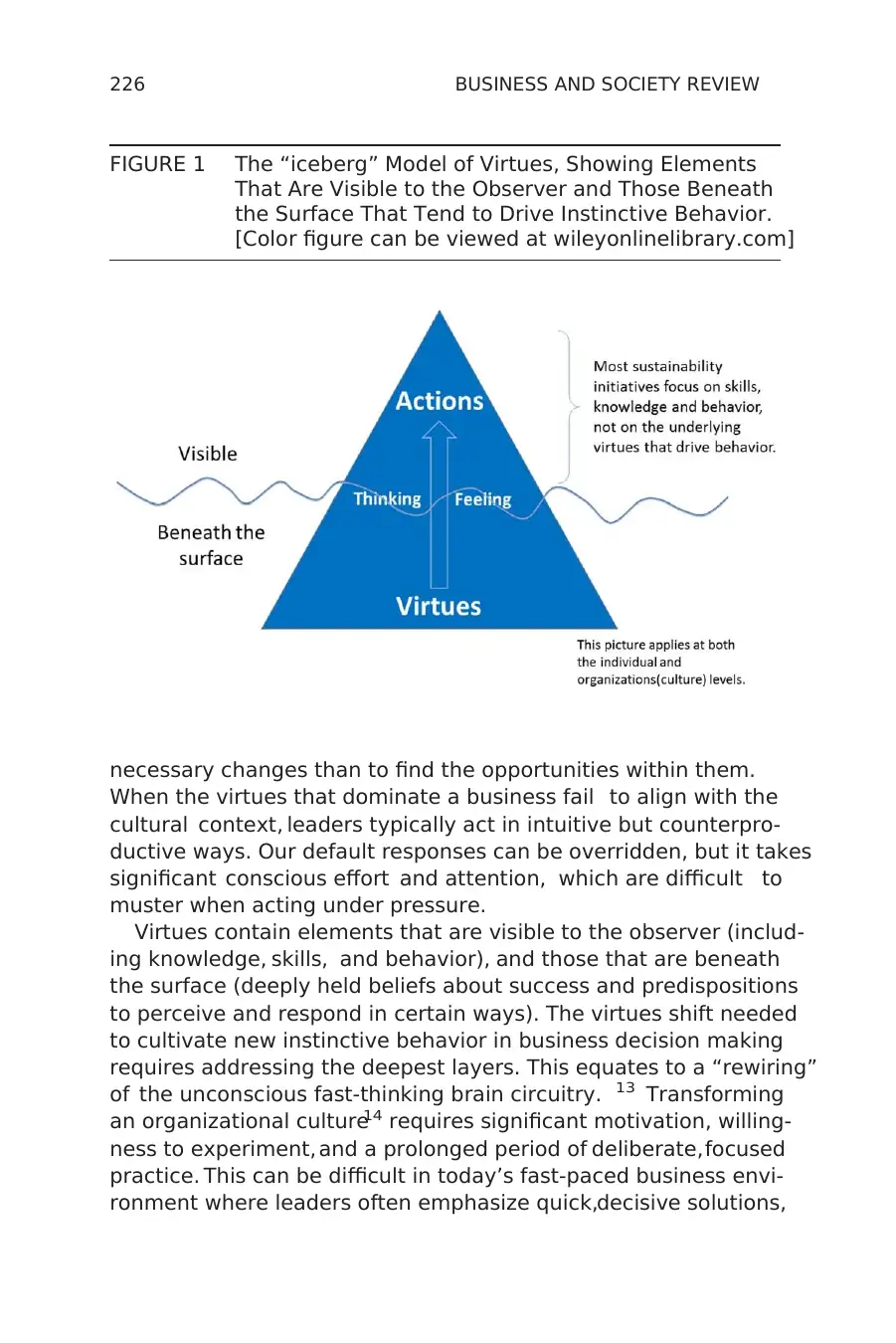
necessary changes than to find the opportunities within them.
When the virtues that dominate a business fail to align with the
cultural context, leaders typically act in intuitive but counterpro-
ductive ways. Our default responses can be overridden, but it takes
significant conscious effort and attention, which are difficult to
muster when acting under pressure.
Virtues contain elements that are visible to the observer (includ-
ing knowledge, skills, and behavior), and those that are beneath
the surface (deeply held beliefs about success and predispositions
to perceive and respond in certain ways). The virtues shift needed
to cultivate new instinctive behavior in business decision making
requires addressing the deepest layers. This equates to a “rewiring”
of the unconscious fast-thinking brain circuitry. 13 Transforming
an organizational culture14 requires significant motivation, willing-
ness to experiment, and a prolonged period of deliberate,focused
practice. This can be difficult in today’s fast-paced business envi-
ronment where leaders often emphasize quick,decisive solutions,
FIGURE 1 The “iceberg” Model of Virtues, Showing Elements
That Are Visible to the Observer and Those Beneath
the Surface That Tend to Drive Instinctive Behavior.
[Color figure can be viewed at wileyonlinelibrary.com]
226 BUSINESS AND SOCIETY REVIEW
When the virtues that dominate a business fail to align with the
cultural context, leaders typically act in intuitive but counterpro-
ductive ways. Our default responses can be overridden, but it takes
significant conscious effort and attention, which are difficult to
muster when acting under pressure.
Virtues contain elements that are visible to the observer (includ-
ing knowledge, skills, and behavior), and those that are beneath
the surface (deeply held beliefs about success and predispositions
to perceive and respond in certain ways). The virtues shift needed
to cultivate new instinctive behavior in business decision making
requires addressing the deepest layers. This equates to a “rewiring”
of the unconscious fast-thinking brain circuitry. 13 Transforming
an organizational culture14 requires significant motivation, willing-
ness to experiment, and a prolonged period of deliberate,focused
practice. This can be difficult in today’s fast-paced business envi-
ronment where leaders often emphasize quick,decisive solutions,
FIGURE 1 The “iceberg” Model of Virtues, Showing Elements
That Are Visible to the Observer and Those Beneath
the Surface That Tend to Drive Instinctive Behavior.
[Color figure can be viewed at wileyonlinelibrary.com]
226 BUSINESS AND SOCIETY REVIEW
⊘ This is a preview!⊘
Do you want full access?
Subscribe today to unlock all pages.

Trusted by 1+ million students worldwide
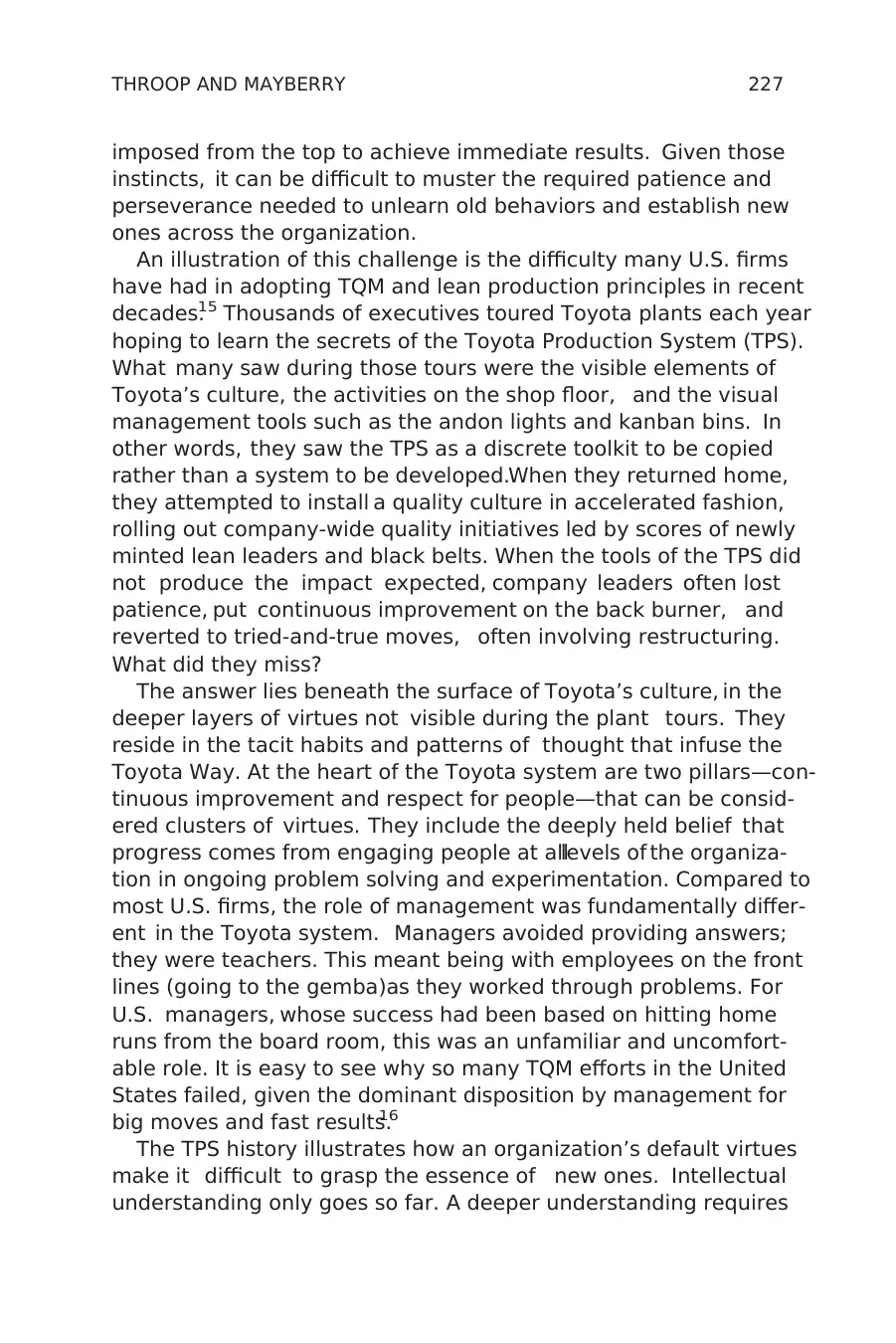
imposed from the top to achieve immediate results. Given those
instincts, it can be difficult to muster the required patience and
perseverance needed to unlearn old behaviors and establish new
ones across the organization.
An illustration of this challenge is the difficulty many U.S. firms
have had in adopting TQM and lean production principles in recent
decades.15 Thousands of executives toured Toyota plants each year
hoping to learn the secrets of the Toyota Production System (TPS).
What many saw during those tours were the visible elements of
Toyota’s culture, the activities on the shop floor, and the visual
management tools such as the andon lights and kanban bins. In
other words, they saw the TPS as a discrete toolkit to be copied
rather than a system to be developed.When they returned home,
they attempted to install a quality culture in accelerated fashion,
rolling out company-wide quality initiatives led by scores of newly
minted lean leaders and black belts. When the tools of the TPS did
not produce the impact expected, company leaders often lost
patience, put continuous improvement on the back burner, and
reverted to tried-and-true moves, often involving restructuring.
What did they miss?
The answer lies beneath the surface of Toyota’s culture, in the
deeper layers of virtues not visible during the plant tours. They
reside in the tacit habits and patterns of thought that infuse the
Toyota Way. At the heart of the Toyota system are two pillars—con-
tinuous improvement and respect for people—that can be consid-
ered clusters of virtues. They include the deeply held belief that
progress comes from engaging people at alllevels of the organiza-
tion in ongoing problem solving and experimentation. Compared to
most U.S. firms, the role of management was fundamentally differ-
ent in the Toyota system. Managers avoided providing answers;
they were teachers. This meant being with employees on the front
lines (going to the gemba)as they worked through problems. For
U.S. managers, whose success had been based on hitting home
runs from the board room, this was an unfamiliar and uncomfort-
able role. It is easy to see why so many TQM efforts in the United
States failed, given the dominant disposition by management for
big moves and fast results.16
The TPS history illustrates how an organization’s default virtues
make it difficult to grasp the essence of new ones. Intellectual
understanding only goes so far. A deeper understanding requires
227THROOP AND MAYBERRY
instincts, it can be difficult to muster the required patience and
perseverance needed to unlearn old behaviors and establish new
ones across the organization.
An illustration of this challenge is the difficulty many U.S. firms
have had in adopting TQM and lean production principles in recent
decades.15 Thousands of executives toured Toyota plants each year
hoping to learn the secrets of the Toyota Production System (TPS).
What many saw during those tours were the visible elements of
Toyota’s culture, the activities on the shop floor, and the visual
management tools such as the andon lights and kanban bins. In
other words, they saw the TPS as a discrete toolkit to be copied
rather than a system to be developed.When they returned home,
they attempted to install a quality culture in accelerated fashion,
rolling out company-wide quality initiatives led by scores of newly
minted lean leaders and black belts. When the tools of the TPS did
not produce the impact expected, company leaders often lost
patience, put continuous improvement on the back burner, and
reverted to tried-and-true moves, often involving restructuring.
What did they miss?
The answer lies beneath the surface of Toyota’s culture, in the
deeper layers of virtues not visible during the plant tours. They
reside in the tacit habits and patterns of thought that infuse the
Toyota Way. At the heart of the Toyota system are two pillars—con-
tinuous improvement and respect for people—that can be consid-
ered clusters of virtues. They include the deeply held belief that
progress comes from engaging people at alllevels of the organiza-
tion in ongoing problem solving and experimentation. Compared to
most U.S. firms, the role of management was fundamentally differ-
ent in the Toyota system. Managers avoided providing answers;
they were teachers. This meant being with employees on the front
lines (going to the gemba)as they worked through problems. For
U.S. managers, whose success had been based on hitting home
runs from the board room, this was an unfamiliar and uncomfort-
able role. It is easy to see why so many TQM efforts in the United
States failed, given the dominant disposition by management for
big moves and fast results.16
The TPS history illustrates how an organization’s default virtues
make it difficult to grasp the essence of new ones. Intellectual
understanding only goes so far. A deeper understanding requires
227THROOP AND MAYBERRY
Paraphrase This Document
Need a fresh take? Get an instant paraphrase of this document with our AI Paraphraser
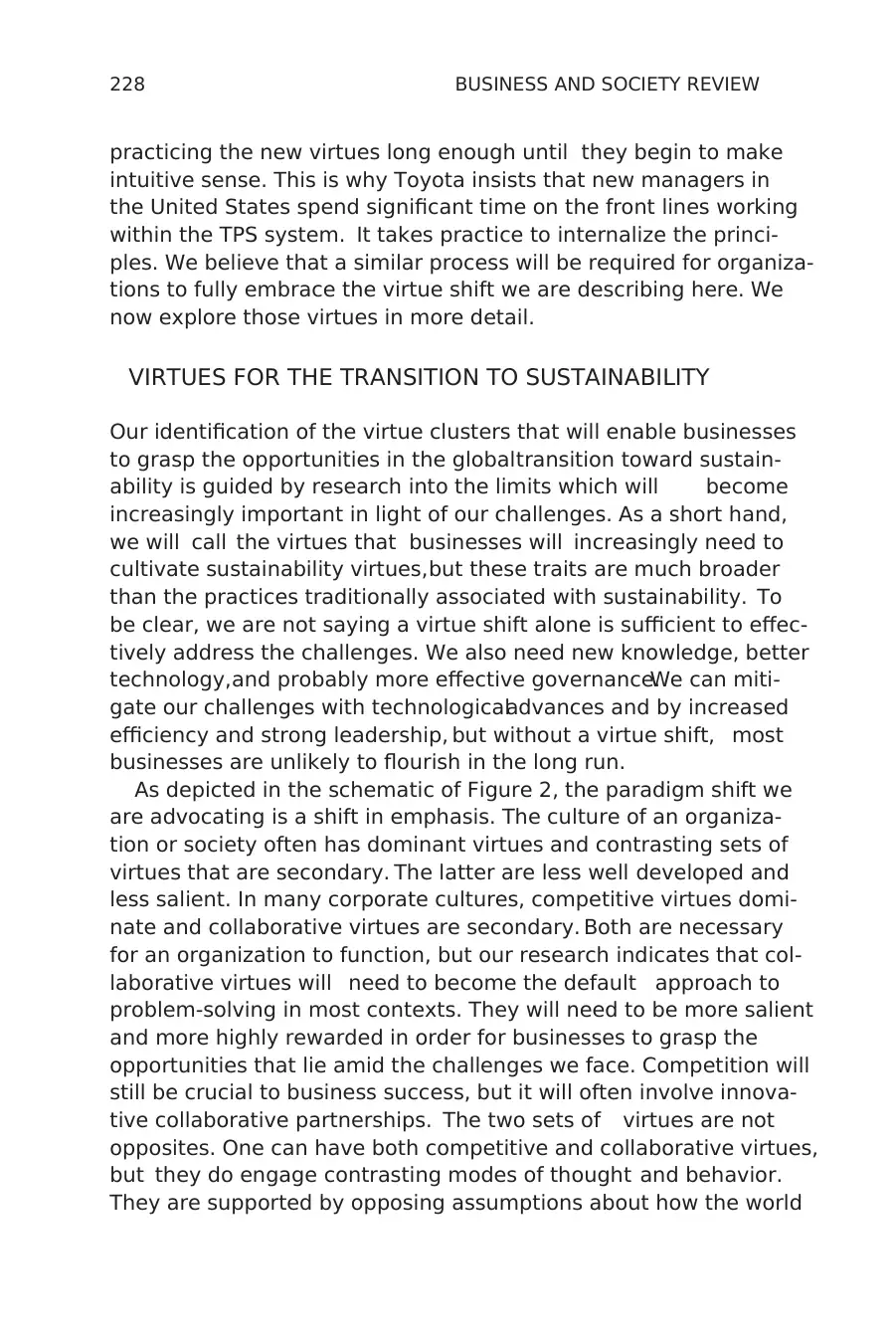
practicing the new virtues long enough until they begin to make
intuitive sense. This is why Toyota insists that new managers in
the United States spend significant time on the front lines working
within the TPS system. It takes practice to internalize the princi-
ples. We believe that a similar process will be required for organiza-
tions to fully embrace the virtue shift we are describing here. We
now explore those virtues in more detail.
VIRTUES FOR THE TRANSITION TO SUSTAINABILITY
Our identification of the virtue clusters that will enable businesses
to grasp the opportunities in the globaltransition toward sustain-
ability is guided by research into the limits which will become
increasingly important in light of our challenges. As a short hand,
we will call the virtues that businesses will increasingly need to
cultivate sustainability virtues,but these traits are much broader
than the practices traditionally associated with sustainability. To
be clear, we are not saying a virtue shift alone is sufficient to effec-
tively address the challenges. We also need new knowledge, better
technology,and probably more effective governance.We can miti-
gate our challenges with technologicaladvances and by increased
efficiency and strong leadership, but without a virtue shift, most
businesses are unlikely to flourish in the long run.
As depicted in the schematic of Figure 2, the paradigm shift we
are advocating is a shift in emphasis. The culture of an organiza-
tion or society often has dominant virtues and contrasting sets of
virtues that are secondary. The latter are less well developed and
less salient. In many corporate cultures, competitive virtues domi-
nate and collaborative virtues are secondary. Both are necessary
for an organization to function, but our research indicates that col-
laborative virtues will need to become the default approach to
problem-solving in most contexts. They will need to be more salient
and more highly rewarded in order for businesses to grasp the
opportunities that lie amid the challenges we face. Competition will
still be crucial to business success, but it will often involve innova-
tive collaborative partnerships. The two sets of virtues are not
opposites. One can have both competitive and collaborative virtues,
but they do engage contrasting modes of thought and behavior.
They are supported by opposing assumptions about how the world
228 BUSINESS AND SOCIETY REVIEW
intuitive sense. This is why Toyota insists that new managers in
the United States spend significant time on the front lines working
within the TPS system. It takes practice to internalize the princi-
ples. We believe that a similar process will be required for organiza-
tions to fully embrace the virtue shift we are describing here. We
now explore those virtues in more detail.
VIRTUES FOR THE TRANSITION TO SUSTAINABILITY
Our identification of the virtue clusters that will enable businesses
to grasp the opportunities in the globaltransition toward sustain-
ability is guided by research into the limits which will become
increasingly important in light of our challenges. As a short hand,
we will call the virtues that businesses will increasingly need to
cultivate sustainability virtues,but these traits are much broader
than the practices traditionally associated with sustainability. To
be clear, we are not saying a virtue shift alone is sufficient to effec-
tively address the challenges. We also need new knowledge, better
technology,and probably more effective governance.We can miti-
gate our challenges with technologicaladvances and by increased
efficiency and strong leadership, but without a virtue shift, most
businesses are unlikely to flourish in the long run.
As depicted in the schematic of Figure 2, the paradigm shift we
are advocating is a shift in emphasis. The culture of an organiza-
tion or society often has dominant virtues and contrasting sets of
virtues that are secondary. The latter are less well developed and
less salient. In many corporate cultures, competitive virtues domi-
nate and collaborative virtues are secondary. Both are necessary
for an organization to function, but our research indicates that col-
laborative virtues will need to become the default approach to
problem-solving in most contexts. They will need to be more salient
and more highly rewarded in order for businesses to grasp the
opportunities that lie amid the challenges we face. Competition will
still be crucial to business success, but it will often involve innova-
tive collaborative partnerships. The two sets of virtues are not
opposites. One can have both competitive and collaborative virtues,
but they do engage contrasting modes of thought and behavior.
They are supported by opposing assumptions about how the world
228 BUSINESS AND SOCIETY REVIEW
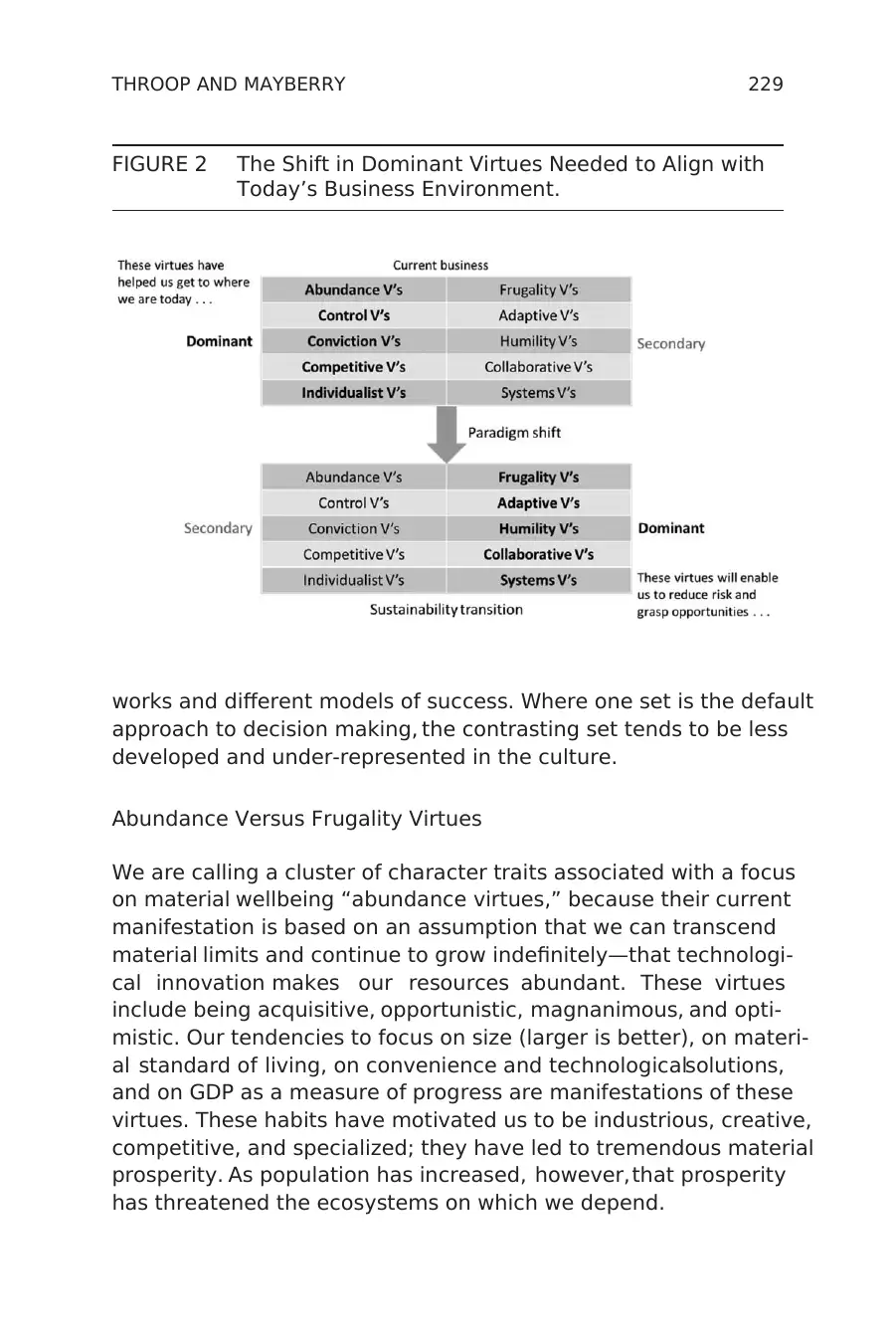
works and different models of success. Where one set is the default
approach to decision making, the contrasting set tends to be less
developed and under-represented in the culture.
Abundance Versus Frugality Virtues
We are calling a cluster of character traits associated with a focus
on material wellbeing “abundance virtues,” because their current
manifestation is based on an assumption that we can transcend
material limits and continue to grow indefinitely—that technologi-
cal innovation makes our resources abundant. These virtues
include being acquisitive, opportunistic, magnanimous, and opti-
mistic. Our tendencies to focus on size (larger is better), on materi-
al standard of living, on convenience and technologicalsolutions,
and on GDP as a measure of progress are manifestations of these
virtues. These habits have motivated us to be industrious, creative,
competitive, and specialized; they have led to tremendous material
prosperity. As population has increased, however,that prosperity
has threatened the ecosystems on which we depend.
FIGURE 2 The Shift in Dominant Virtues Needed to Align with
Today’s Business Environment.
229THROOP AND MAYBERRY
approach to decision making, the contrasting set tends to be less
developed and under-represented in the culture.
Abundance Versus Frugality Virtues
We are calling a cluster of character traits associated with a focus
on material wellbeing “abundance virtues,” because their current
manifestation is based on an assumption that we can transcend
material limits and continue to grow indefinitely—that technologi-
cal innovation makes our resources abundant. These virtues
include being acquisitive, opportunistic, magnanimous, and opti-
mistic. Our tendencies to focus on size (larger is better), on materi-
al standard of living, on convenience and technologicalsolutions,
and on GDP as a measure of progress are manifestations of these
virtues. These habits have motivated us to be industrious, creative,
competitive, and specialized; they have led to tremendous material
prosperity. As population has increased, however,that prosperity
has threatened the ecosystems on which we depend.
FIGURE 2 The Shift in Dominant Virtues Needed to Align with
Today’s Business Environment.
229THROOP AND MAYBERRY
⊘ This is a preview!⊘
Do you want full access?
Subscribe today to unlock all pages.

Trusted by 1+ million students worldwide
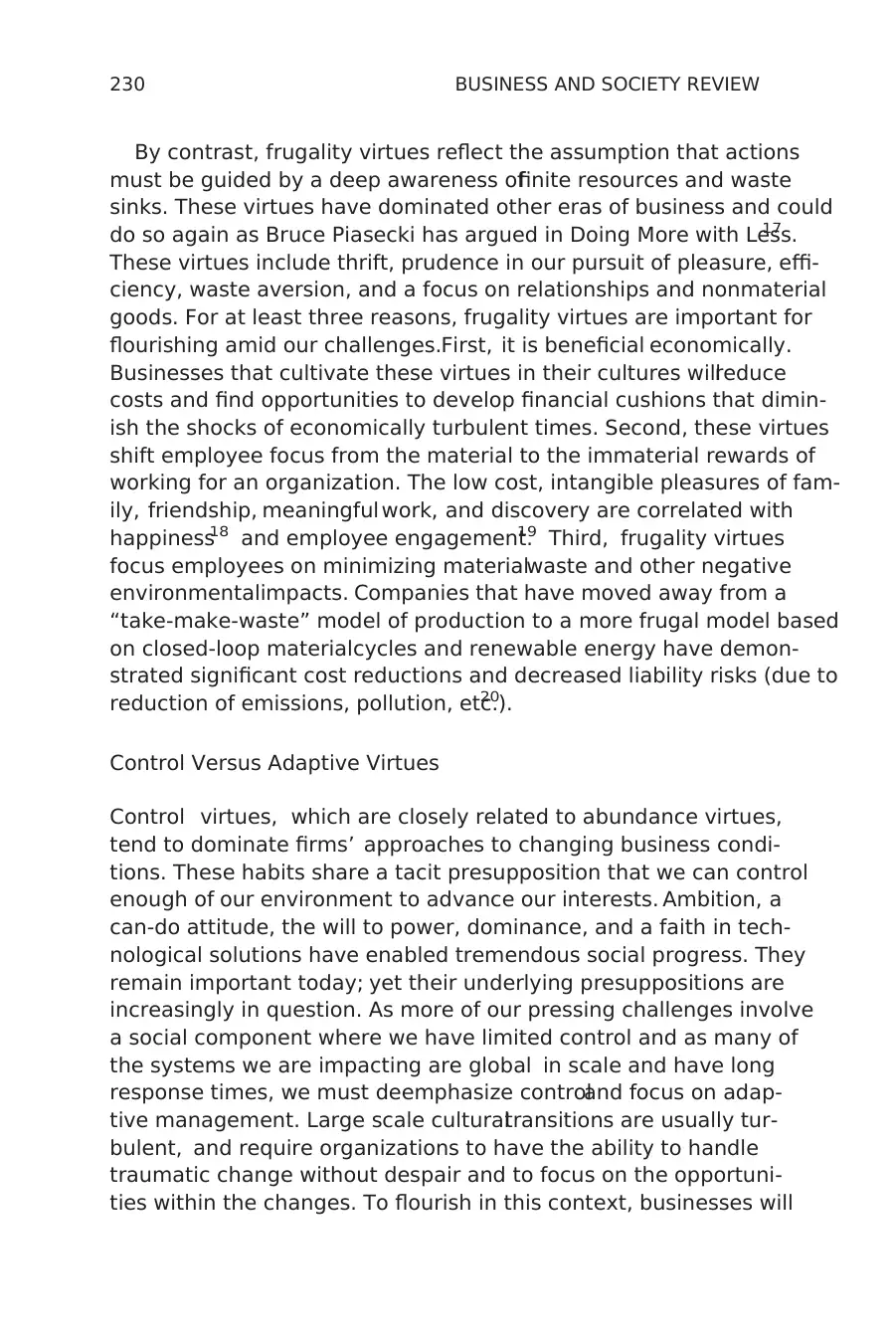
By contrast, frugality virtues reflect the assumption that actions
must be guided by a deep awareness offinite resources and waste
sinks. These virtues have dominated other eras of business and could
do so again as Bruce Piasecki has argued in Doing More with Less.17
These virtues include thrift, prudence in our pursuit of pleasure, effi-
ciency, waste aversion, and a focus on relationships and nonmaterial
goods. For at least three reasons, frugality virtues are important for
flourishing amid our challenges.First, it is beneficial economically.
Businesses that cultivate these virtues in their cultures willreduce
costs and find opportunities to develop financial cushions that dimin-
ish the shocks of economically turbulent times. Second, these virtues
shift employee focus from the material to the immaterial rewards of
working for an organization. The low cost, intangible pleasures of fam-
ily, friendship, meaningful work, and discovery are correlated with
happiness18 and employee engagement.19 Third, frugality virtues
focus employees on minimizing materialwaste and other negative
environmentalimpacts. Companies that have moved away from a
“take-make-waste” model of production to a more frugal model based
on closed-loop materialcycles and renewable energy have demon-
strated significant cost reductions and decreased liability risks (due to
reduction of emissions, pollution, etc.).20
Control Versus Adaptive Virtues
Control virtues, which are closely related to abundance virtues,
tend to dominate firms’ approaches to changing business condi-
tions. These habits share a tacit presupposition that we can control
enough of our environment to advance our interests. Ambition, a
can-do attitude, the will to power, dominance, and a faith in tech-
nological solutions have enabled tremendous social progress. They
remain important today; yet their underlying presuppositions are
increasingly in question. As more of our pressing challenges involve
a social component where we have limited control and as many of
the systems we are impacting are global in scale and have long
response times, we must deemphasize controland focus on adap-
tive management. Large scale culturaltransitions are usually tur-
bulent, and require organizations to have the ability to handle
traumatic change without despair and to focus on the opportuni-
ties within the changes. To flourish in this context, businesses will
230 BUSINESS AND SOCIETY REVIEW
must be guided by a deep awareness offinite resources and waste
sinks. These virtues have dominated other eras of business and could
do so again as Bruce Piasecki has argued in Doing More with Less.17
These virtues include thrift, prudence in our pursuit of pleasure, effi-
ciency, waste aversion, and a focus on relationships and nonmaterial
goods. For at least three reasons, frugality virtues are important for
flourishing amid our challenges.First, it is beneficial economically.
Businesses that cultivate these virtues in their cultures willreduce
costs and find opportunities to develop financial cushions that dimin-
ish the shocks of economically turbulent times. Second, these virtues
shift employee focus from the material to the immaterial rewards of
working for an organization. The low cost, intangible pleasures of fam-
ily, friendship, meaningful work, and discovery are correlated with
happiness18 and employee engagement.19 Third, frugality virtues
focus employees on minimizing materialwaste and other negative
environmentalimpacts. Companies that have moved away from a
“take-make-waste” model of production to a more frugal model based
on closed-loop materialcycles and renewable energy have demon-
strated significant cost reductions and decreased liability risks (due to
reduction of emissions, pollution, etc.).20
Control Versus Adaptive Virtues
Control virtues, which are closely related to abundance virtues,
tend to dominate firms’ approaches to changing business condi-
tions. These habits share a tacit presupposition that we can control
enough of our environment to advance our interests. Ambition, a
can-do attitude, the will to power, dominance, and a faith in tech-
nological solutions have enabled tremendous social progress. They
remain important today; yet their underlying presuppositions are
increasingly in question. As more of our pressing challenges involve
a social component where we have limited control and as many of
the systems we are impacting are global in scale and have long
response times, we must deemphasize controland focus on adap-
tive management. Large scale culturaltransitions are usually tur-
bulent, and require organizations to have the ability to handle
traumatic change without despair and to focus on the opportuni-
ties within the changes. To flourish in this context, businesses will
230 BUSINESS AND SOCIETY REVIEW
Paraphrase This Document
Need a fresh take? Get an instant paraphrase of this document with our AI Paraphraser
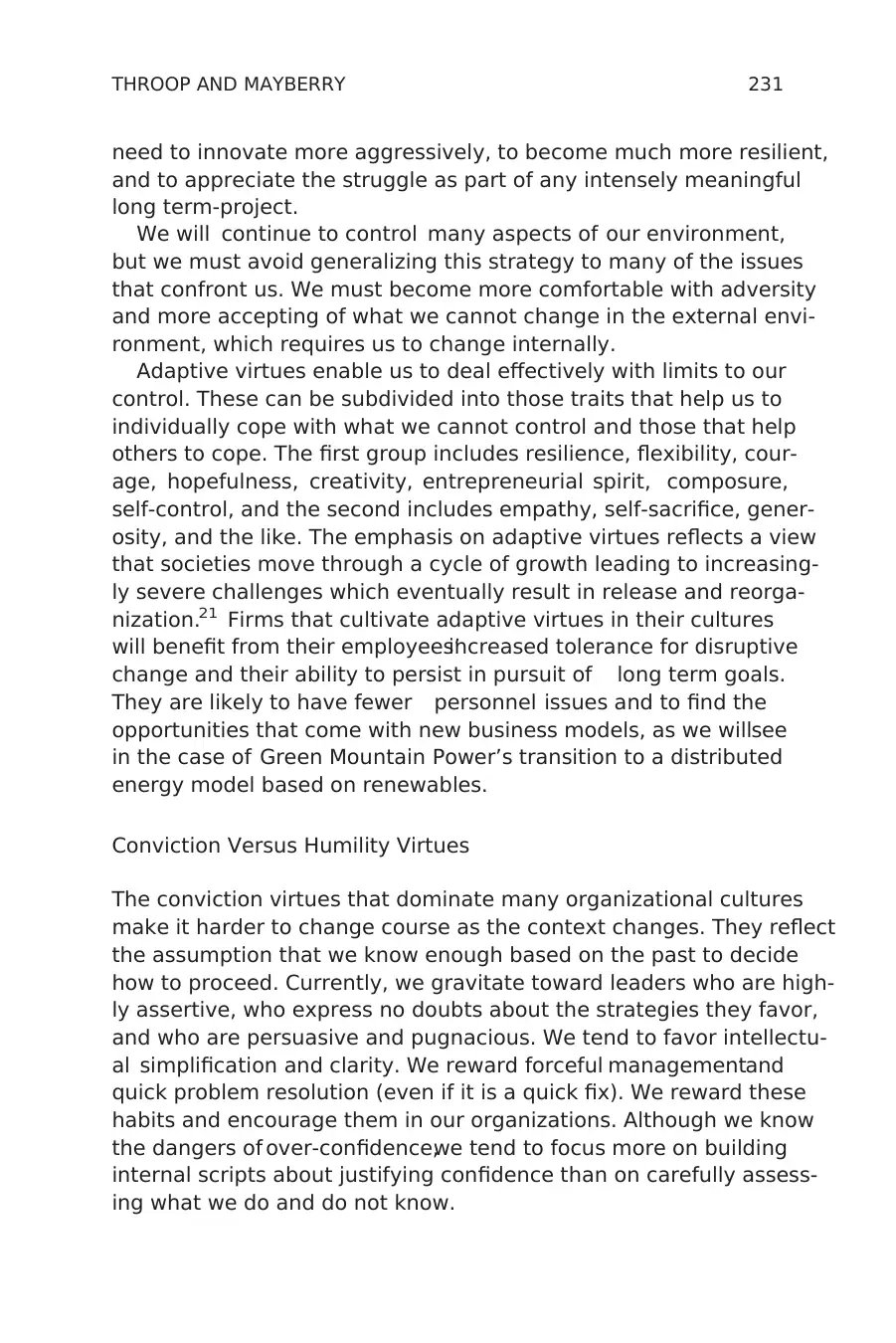
need to innovate more aggressively, to become much more resilient,
and to appreciate the struggle as part of any intensely meaningful
long term-project.
We will continue to control many aspects of our environment,
but we must avoid generalizing this strategy to many of the issues
that confront us. We must become more comfortable with adversity
and more accepting of what we cannot change in the external envi-
ronment, which requires us to change internally.
Adaptive virtues enable us to deal effectively with limits to our
control. These can be subdivided into those traits that help us to
individually cope with what we cannot control and those that help
others to cope. The first group includes resilience, flexibility, cour-
age, hopefulness, creativity, entrepreneurial spirit, composure,
self-control, and the second includes empathy, self-sacrifice, gener-
osity, and the like. The emphasis on adaptive virtues reflects a view
that societies move through a cycle of growth leading to increasing-
ly severe challenges which eventually result in release and reorga-
nization.21 Firms that cultivate adaptive virtues in their cultures
will benefit from their employees’increased tolerance for disruptive
change and their ability to persist in pursuit of long term goals.
They are likely to have fewer personnel issues and to find the
opportunities that come with new business models, as we willsee
in the case of Green Mountain Power’s transition to a distributed
energy model based on renewables.
Conviction Versus Humility Virtues
The conviction virtues that dominate many organizational cultures
make it harder to change course as the context changes. They reflect
the assumption that we know enough based on the past to decide
how to proceed. Currently, we gravitate toward leaders who are high-
ly assertive, who express no doubts about the strategies they favor,
and who are persuasive and pugnacious. We tend to favor intellectu-
al simplification and clarity. We reward forceful managementand
quick problem resolution (even if it is a quick fix). We reward these
habits and encourage them in our organizations. Although we know
the dangers of over-confidence,we tend to focus more on building
internal scripts about justifying confidence than on carefully assess-
ing what we do and do not know.
231THROOP AND MAYBERRY
and to appreciate the struggle as part of any intensely meaningful
long term-project.
We will continue to control many aspects of our environment,
but we must avoid generalizing this strategy to many of the issues
that confront us. We must become more comfortable with adversity
and more accepting of what we cannot change in the external envi-
ronment, which requires us to change internally.
Adaptive virtues enable us to deal effectively with limits to our
control. These can be subdivided into those traits that help us to
individually cope with what we cannot control and those that help
others to cope. The first group includes resilience, flexibility, cour-
age, hopefulness, creativity, entrepreneurial spirit, composure,
self-control, and the second includes empathy, self-sacrifice, gener-
osity, and the like. The emphasis on adaptive virtues reflects a view
that societies move through a cycle of growth leading to increasing-
ly severe challenges which eventually result in release and reorga-
nization.21 Firms that cultivate adaptive virtues in their cultures
will benefit from their employees’increased tolerance for disruptive
change and their ability to persist in pursuit of long term goals.
They are likely to have fewer personnel issues and to find the
opportunities that come with new business models, as we willsee
in the case of Green Mountain Power’s transition to a distributed
energy model based on renewables.
Conviction Versus Humility Virtues
The conviction virtues that dominate many organizational cultures
make it harder to change course as the context changes. They reflect
the assumption that we know enough based on the past to decide
how to proceed. Currently, we gravitate toward leaders who are high-
ly assertive, who express no doubts about the strategies they favor,
and who are persuasive and pugnacious. We tend to favor intellectu-
al simplification and clarity. We reward forceful managementand
quick problem resolution (even if it is a quick fix). We reward these
habits and encourage them in our organizations. Although we know
the dangers of over-confidence,we tend to focus more on building
internal scripts about justifying confidence than on carefully assess-
ing what we do and do not know.
231THROOP AND MAYBERRY
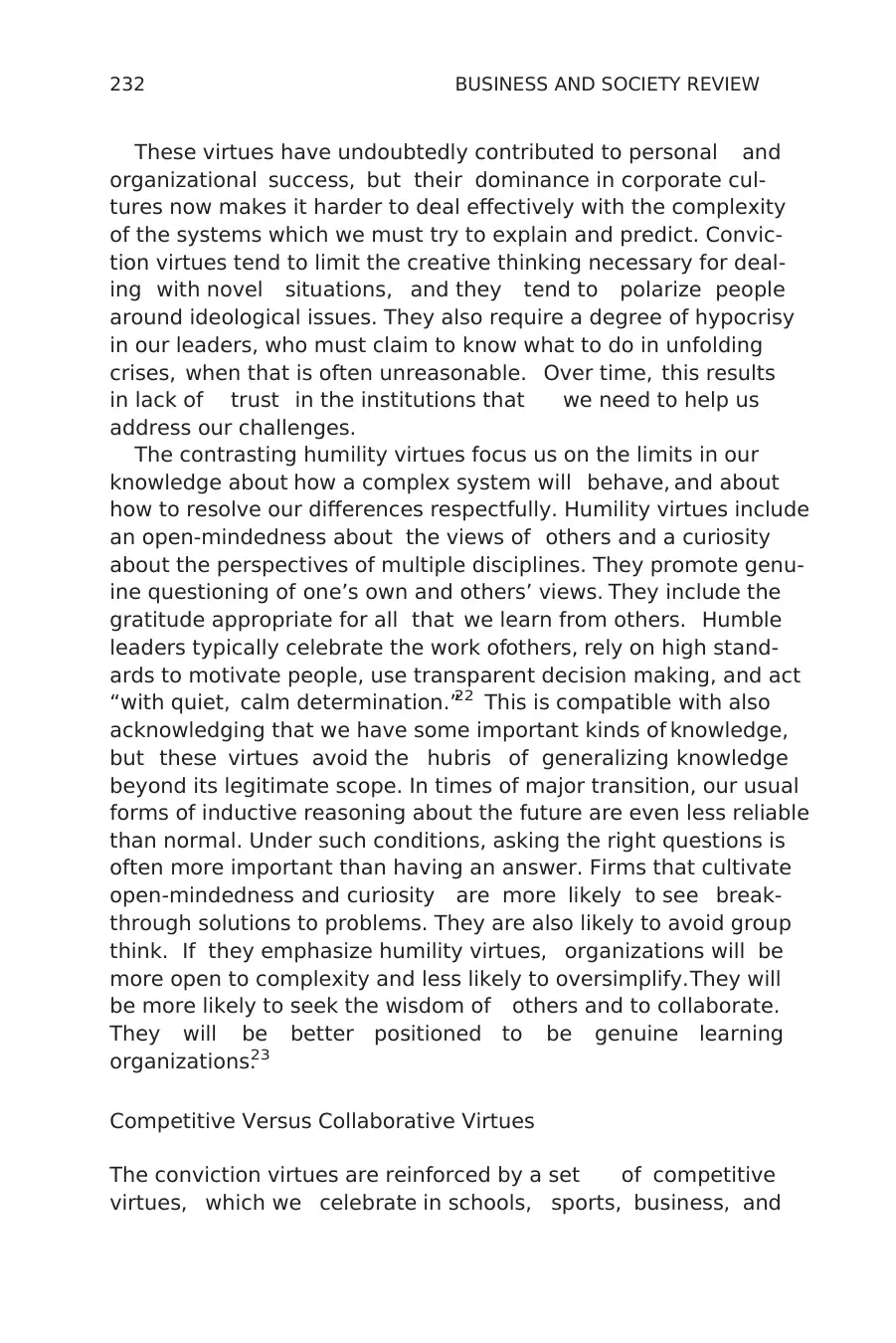
These virtues have undoubtedly contributed to personal and
organizational success, but their dominance in corporate cul-
tures now makes it harder to deal effectively with the complexity
of the systems which we must try to explain and predict. Convic-
tion virtues tend to limit the creative thinking necessary for deal-
ing with novel situations, and they tend to polarize people
around ideological issues. They also require a degree of hypocrisy
in our leaders, who must claim to know what to do in unfolding
crises, when that is often unreasonable. Over time, this results
in lack of trust in the institutions that we need to help us
address our challenges.
The contrasting humility virtues focus us on the limits in our
knowledge about how a complex system will behave, and about
how to resolve our differences respectfully. Humility virtues include
an open-mindedness about the views of others and a curiosity
about the perspectives of multiple disciplines. They promote genu-
ine questioning of one’s own and others’ views. They include the
gratitude appropriate for all that we learn from others. Humble
leaders typically celebrate the work ofothers, rely on high stand-
ards to motivate people, use transparent decision making, and act
“with quiet, calm determination.”22 This is compatible with also
acknowledging that we have some important kinds of knowledge,
but these virtues avoid the hubris of generalizing knowledge
beyond its legitimate scope. In times of major transition, our usual
forms of inductive reasoning about the future are even less reliable
than normal. Under such conditions, asking the right questions is
often more important than having an answer. Firms that cultivate
open-mindedness and curiosity are more likely to see break-
through solutions to problems. They are also likely to avoid group
think. If they emphasize humility virtues, organizations will be
more open to complexity and less likely to oversimplify.They will
be more likely to seek the wisdom of others and to collaborate.
They will be better positioned to be genuine learning
organizations.23
Competitive Versus Collaborative Virtues
The conviction virtues are reinforced by a set of competitive
virtues, which we celebrate in schools, sports, business, and
232 BUSINESS AND SOCIETY REVIEW
organizational success, but their dominance in corporate cul-
tures now makes it harder to deal effectively with the complexity
of the systems which we must try to explain and predict. Convic-
tion virtues tend to limit the creative thinking necessary for deal-
ing with novel situations, and they tend to polarize people
around ideological issues. They also require a degree of hypocrisy
in our leaders, who must claim to know what to do in unfolding
crises, when that is often unreasonable. Over time, this results
in lack of trust in the institutions that we need to help us
address our challenges.
The contrasting humility virtues focus us on the limits in our
knowledge about how a complex system will behave, and about
how to resolve our differences respectfully. Humility virtues include
an open-mindedness about the views of others and a curiosity
about the perspectives of multiple disciplines. They promote genu-
ine questioning of one’s own and others’ views. They include the
gratitude appropriate for all that we learn from others. Humble
leaders typically celebrate the work ofothers, rely on high stand-
ards to motivate people, use transparent decision making, and act
“with quiet, calm determination.”22 This is compatible with also
acknowledging that we have some important kinds of knowledge,
but these virtues avoid the hubris of generalizing knowledge
beyond its legitimate scope. In times of major transition, our usual
forms of inductive reasoning about the future are even less reliable
than normal. Under such conditions, asking the right questions is
often more important than having an answer. Firms that cultivate
open-mindedness and curiosity are more likely to see break-
through solutions to problems. They are also likely to avoid group
think. If they emphasize humility virtues, organizations will be
more open to complexity and less likely to oversimplify.They will
be more likely to seek the wisdom of others and to collaborate.
They will be better positioned to be genuine learning
organizations.23
Competitive Versus Collaborative Virtues
The conviction virtues are reinforced by a set of competitive
virtues, which we celebrate in schools, sports, business, and
232 BUSINESS AND SOCIETY REVIEW
⊘ This is a preview!⊘
Do you want full access?
Subscribe today to unlock all pages.

Trusted by 1+ million students worldwide
1 out of 30
Your All-in-One AI-Powered Toolkit for Academic Success.
+13062052269
info@desklib.com
Available 24*7 on WhatsApp / Email
![[object Object]](/_next/static/media/star-bottom.7253800d.svg)
Unlock your academic potential
Copyright © 2020–2025 A2Z Services. All Rights Reserved. Developed and managed by ZUCOL.